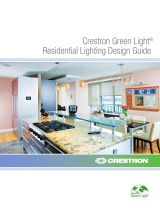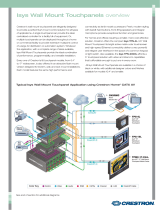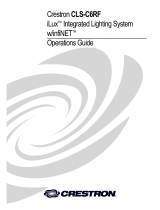Page is loading ...

Quick Start
Crestron® Horizon™ HZ-KPCN-series precision keypads provide optimal control of Crestron
devices such as lighting, shading, and A/V equipment from a single location. Each keypad offers
up to five tactile button or rocker switch positions, multicolor LED backlighting, laser-engraved
buttons and customizable faceplates designed to meet your needs. Simply connect the keypad
directly to your Cresnet® control network to begin.
Check the Box
Item Qty
HZ-KPCN* 1
Connector, 3-Pin (P/N 2003575) 1
Connector, 4-Pin (P/N 2003576) 2
Trim Plate* 2
Trim Plate, Textured* 2
Button Cap, Single Button* 5
Screw, 6-32 x 3/4 in., Truss Head, Combo (P/N 2009211) 2
Screw, 4-40 x 1/4 in., Flat Head, Philips (P/N 2050242) 2
Metal, Plate, Mounting (P/N 2052028) 1
* Available in a variety of colors and textures. Please refer to the Crestron website for a complete list of
options.
Wire the Keypad
To wire the keypad, connect the NET and INPUT ports as needed.
INPUT:
From contact closure or
non-system occupancy sensor
(e.g., GLS-ODT-C-NS).
NET:
Communications from control
system and/or daisy-chained
Cresnet device.
Install the Keypad
CAUTION: Do not mix high- and low-voltage devices in the same electrical box without an
approved barrier.
NOTE: Before operating the HZ-KPCN, ensure the device is using the latest firmware. Check
for the latest HZ-KPCN firmware at www.crestron.com/firmware. Load the firmware onto the
device using Crestron Toolbox™ software.
The Horizon keypad is designed for installation into a standard, single-gang electrical box. For
larger applications, combine up to four keypads in a multi-gang electrical box.
To install the keypad:
1. Turn the system power OFF.
2. Place the metal mounting bracket over the back of the HZ-KPCN. The two parts of the
metal bracket clip together which allows the wiring to remain in place.
3. Fold the wires into the electrical box. Avoid pinched wires.
4. Secure the HZ-KPCN to the electrical box using the integrated mounting screws on the
device. Ensure that the “Top” label is properly oriented.
CAUTION: Do not overtighten the screws when attaching the keypad to the electrical box,
damage to the unit and undesired functionality may occur.
5. Attach the magnetic top and bottom trim pieces to the faceplate.
6. Ensure that all buttons actuate without sticking.
7. Turn the system power ON.
Wall
Electrical Box
(not supplied)
Metal Mounting
Bracket
(top and bottom)
HZ-KPCN
Faceplate
Trim (x2)
Button Cap Configurations
The keypad button layout is configurable to suit a wide range of uses. The keypad is configured
using a variety of button caps, which may include a single pushbutton or horizontal rocker switch
cap. Larger vertical rocker switch caps are also available. All button caps are intended to be
laser-engraved to identify each button’s function.
The HZ-KPCN offers the following button-cap configurations:
Five Buttons:
HZ-BTN-1 or
HZ-BTN-RKR1
Three Buttons:
HZ-BTN-1 or HZ-BTN-RKR1 and
HZ-BTN-RKR3
One Button:
HZ-BTN-RKR5
• HZ-BTN-1: One-row button cap, center press (supplied - qty. 5)
• HZ-BTN-RKR1: One-row rocker button cap, left/right press (not supplied)
• HZ-BTN-RKR3: Three-row rocker button cap, top/bottom press (not supplied)
• HZ-BTN-RKR5: Five-row rocker button cap, top/bottom press (not supplied)
To replace button caps:
1. Remove the top trim piece.
2. Remove the old button cap using the flat end of the spudger (supplied with engraved
buttons):
a. Insert the spudger between the top of the button cap and the keypad near the left
edge of the button. Rotate the spudger tool counterclockwise to remove the left side of
the button cap.
b. Insert the spudger between the top of the button cap and the keypad near the right
edge of the button. Rotate the spudger tool clockwise to remove the right side of the
button cap.
NOTE: For the 3 and 5 position button caps, repeat step 2 but insert the spudger between
the bottom of the button cap and the keypad.
Spudger
tool
3. Align the posts on the back of the new button cap with the slot in the keypad and press
firmly onto the keypad. Ensure that the button cap actuates without sticking.
4. Replace the top trim piece.
Scan or click the
QR code to view
a video tutorial
of the button
cap replacement
process.
HZ-KPCN
Horizon™ Keypads

Ambient Light Sensor Calibration
Behind each button is an LED backlight, which illuminates the
engraving. The ambient light sensor adjusts the keypad’s backlight
brightness according to the light level in the room. Once the custom,
laser-engraved buttons are installed, the ambient light sensor must be
calibrated.
NOTE: The LED backlight is enabled after light sensor calibration.
Calibrate the light sensor:
1. Ensure the faceplate and bottom trim piece are installed
correctly. Remove the top trim piece.
2. Press and hold the setup button using the pointed end of the
supplied spudger tool until all keypad backlights flash magenta
(about 2 seconds).
3. Avoid blocking the light sensor on the bottom of the HZ-KPCN.
The light sensor should remain unobstructed and free of direct
light. After about 5 seconds, the calibration process is complete.
The keypad returns to normal operation.
Setup
button
Backlight Customization
To change the color of the LED backlights:
1. Press the setup button once using the pointed end of the spudger
tool. The LED backlights will light brightly for 15 seconds.
2. Press the setup button repeatedly to cycle through the backlight
color options.
NOTE: Custom color themes may be defined in the control system
program.
Technical Specifications
Visit the product web page for complete technical specifications.
Specification Details
Power Requirements
Cresnet Power Usage
Power Consumption
2 W (83 mA @ 24 VDC)
2 W maximum
INPUT Port (2) digital/analog input ports
(referenced to GND);
Digital Input: Rated for 0-24 Volts DC,
input impedance 200k Ohms, logic
threshold 1.24 Volts DC;
Analog Input: Rated for 0-10 Volts DC,
protected to 24 Volts DC maximum, input
impedance 200k Ohms;
Programmable 3 Volts, 2k Ohms pull-up
resistor per input
Environmental
Temperature
Humidity
Heat Dissipation
32º to 104 ºF (0º to 40 ºC)
10% to 90% RH (non-condensing)
6.8 Btu/h maximum
Dimensions
3-9/32 in.
(83 mm)
4-1/8 in.
(105 mm)
1-13/16 in.
(46 mm)
3-1/16 in.
(78 mm)
4-23/32 in.
(120 mm)
15/16 in.
(24 mm)
5/8 in.
(16 mm)
2-23/32 in.
(69 mm)
3/8 in.
(10 mm)
1-3/4 in.
(44 mm)
Setup
button
Light
sensor
Troubleshooting
The following table provides corrective action for possible trouble
situations. If further assistance is required, please contact a Crestron
Customer service representative.
Symptom Issue Action
No action is
performed when
a button on
the keypad is
pressed.
The unit is not
receiving
24 VDC Power.
Check wiring for 24 VDC
power.
There is an error in
the control system
program.
Verify that the control
system program is correct.
The LEDs do not
light.
The LEDs are not
enabled.
Perform Light Sensor
Calibration to enable the
LEDs.
The keypad
button(s) do not
actuate when
pressed.
The keypad
mounting screws are
overtightened.
Slightly loosen the
mounting screws.
The button may not
be snapped into the
keypad.
Ensure that the button cap
is properly oriented and
installed.
The backlight
LEDs are too
bright when the
room is dark.
The keypad may be
staying in Day mode.
While in Day mode
the LEDs are typically
full brightness or off.
Check the
DayNightThreshold setting
in the control system
program. If set to Default,
rerun the calibration
process from the keypad.
Change the
DayNightThreshold
Calibration setting to
Med-Bright or Bright in the
control system program
to ensure Night mode is
entered when the room is
dark.
The LED brightness
settings for Night
mode may be
incorrect.
Adjust the Keypad
Brightness settings in the
control system program.
The backlight
LEDs are too
dim or not
visible.
The keypad may
be staying in Night
mode as the room
transitions from
Dark to Dim. While in
Night mode the LEDs
are typically at very
low brightness.
Change the
DayNightThreshold
Calibration setting to Med-
Dark or Dark in the control
system program to ensure
Day mode is entered when
the room brightens.
Calibration may have been
run when the lower trim
piece was not installed.
Replace lower trim and
rerun calibration.
For Additional Information
Scan or click the QR code for detailed product information.
HZ-KPCN
Compliance and Legal
Original Instructions: The U.S. English version of this document is the original instructions. All other languages are a translation
of the original instructions.
Federal Communications Commission (FCC) Compliance Statement
This device complies with part 15 of the FCC Rules. Operation is subject to the following conditions:(1) This device may not
cause harmful interference and (2) this device must accept any interference received, including interference that may cause
undesired operation.
CAUTION: Changes or modifications not expressly approved by the manufacturer responsible for compliance could void the
user’s authority to operate the equipment.
NOTE: This equipment has been tested and found to comply with the limits for a Class B digital device, pursuant to part 15
of the FCC Rules. These limits are designed to provide reasonable protection against harmful interference in a residential
installation. This equipment generates, uses and can radiate radio frequency energy and, if not installed and used in
accordance with the instructions, may cause harmful interference to radio communications. However, there is no guarantee
that interference will not occur in a particular installation. If this equipment does cause harmful interference to radio or
television reception, which can be determined by turning the equipment off and on, the user is encouraged to try to correct the
interference by one or more of the following measures:
• Reorient or relocate the receiving antenna.
• Increase the separation between the equipment and receiver.
• Connect the equipment into an outlet on a circuit different from that to which the receiver is connected.
• Consult the dealer or an experienced radio/TV technician for help.
Industry Canada (IC) Compliance Statement
CAN ICES-3 (B)/NMB-3(B)
The product warranty can be found at www.crestron.com/warranty.
The specific patents that cover Crestron products are listed at www.crestron.com/legal/patents.
Certain Crestron products contain open source software. For specific information, please visit www.crestron.com/opensource.
Crestron, the Crestron logo, Crestron Toolbox, Cresnet, and Horizon are either trademarks or registered trademarks of
Crestron Electronics, Inc. in the United States and/or other countries. Other trademarks, registered trademarks, and trade
names may be used in this document to refer to either the entities claiming the marks and names or their products. Crestron
disclaims any proprietary interest in the marks and names of others. Crestron is not responsible for errors in typography or
photography.
©2018 Crestron Electronics, Inc.
Crestron Electronics, Inc.
15 Volvo Drive, Rockleigh, NJ 07647
Tel: 888.CRESTRON
Fax: 201.767.7576
www.crestron.com
Quick Start - Doc. 8285C
(2053091)
12.18
Specifications subject to
change without notice.
/




